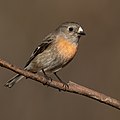| Petroica | |
|---|---|
 | |
| North Island robin (Petroica longipes) | |
| Scientific classification | |
| Kingdom: | Animalia |
| Phylum: | Chordata |
| Class: | Aves |
| Order: | Passeriformes |
| Family: | Petroicidae |
| Genus: | Petroica Swainson, 1829 |
| Type species | |
| Muscicapa multicolor [1] Gmelin, 1789 | |
| Species | |
14; see text | |
Petroica is a genus of Australasian robins, named for their red and pink markings. They are not closely related to the European robins nor the American robins.















